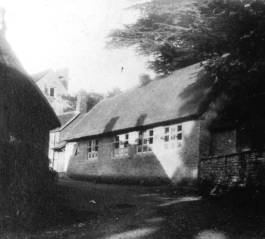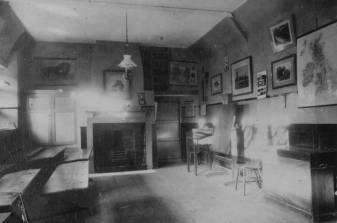
The Inspector Calls
Newsletter 18. May 1999
Early Schooling
Few would claim that modern-day teachers have an easy life. If only their problems were limited to the children. But there are troublesome parents, bureaucratic regulations and an onerous National Curriculum. And periodically, schools are subject to stressful inspections by OFSTED (the schools standards agency). Some may think that these pressures are recent, but they have been around almost as long as we have had schools.
The School Inspector
The government introduced school inspection in 1839 but it was twenty years before there were enough inspectors to regularly visit schools. Many were not popular. In the 1880s, the inspector for Finmere was an elderly clergyman, the Reverend Pickard. In her book, Lark Rise to Candleford, Flora Thompson described Pickard’s visit to her school in Cottisford. She was not impressed:
[Pickard had] an immense paunch and tiny grey eyes like gimlets. He had the reputation of being “strict”, but that was a mild way of describing his autocratic demeanour and scathing judgement. His voice was an exasperated roar and his criticism was a blend of outraged learning and sarcasm.
Neither did she like the way he worked:
He looked at the rows of children as though he hated them and at the mistress as if he despised her. But slowly as the hands of the clock seemed to move, the afternoon wore on. Classes came out and toed the chalk line to read; other classes bent over their sums, or wrote letters to grandmothers describing imaginary holidays. Some wrote to the great man’s pieces full of hard spelling words.
The pupils were well aware of the need to be on their best behaviour:
There was no singing or quarrelling on the way to school that morning. The children in clean pinafores and well blackened boots, walked deep in thought; or, with open spelling or table books in hand, tried to make up in an hour for all their wasted yesterdays.
But their attempts to catch up were to little avail:
The very sound of [Pickard’s] voice scattered the wits of the less gifted, and even those who could have done better were too terrified in his presence to be able to collect their thoughts or keep their hands from trembling.
Not all inspectors were as terrifying as Pickard. But inspection and examination were a regular part of nineteenth century school life.
The text above is as originally published but I am now uncertain that Pickard was the right age to be Flora's elderly Inspector. Further research is needed. Andy Boddington 2001.
The First Finmere Schools
There has been a school in Finmere for more than two hundred years. The first known teacher is William Malins, who was master of the school from 1779 or earlier. His school had seventy children. This seems a large number for a parish of about three hundred people, though Malins had ten children himself.
Many families would send their children to school almost as soon as they could walk. Mothers had to work on the land, make lace or work in service. Older children were expected to be childminders. If the older children were to go to school, the infants had to go with them. The children would be taught in two classes, infants and children over six. The the older children would help supervise the infants.
The church and the Duke of Buckingham initially funded Finmere’s school. At first, the lessons would have been in a house, perhaps part of the Rectory, or in the church. This arrangement was not satisfactory and, in 1824, the Duke paid for a new schoolroom to be built near the church. The photograph below was taken in 1906. The thatch of the old post office can be seen on the left.

Accounts for Finmere school survive from 1874. The school spent £43 1s that year, mostly on salaries for the teacher, Miss Barbara Steven and her assistant, Ann Berry. Other costs included £4 6s 9p for two-and-a-half tons of coal, 3s for a new broom and 2s for a bottle of ink.
This expenditure was covered by donations totalling £46 8s from villagers and the Rector, who paid £11 15s. Parents paid “school pence,” a few pence a week for each child. There were also government grants, which paid half the teacher’s salary.
The Inspector Calls
With the government grants came Her Majesty’s Inspector. In 1874, Barbara Stephen dutifully copied the Inspector’s report into the school log book:
The infants can read and spell fairly, but their writing and arithmetic is very moderate. Among the elder children reading and writing is tolerable; spelling is bad, and arithmetic very bad.
Teachers then received little formal training and received their teaching certificate after a year or so in the classroom — if the Inspector was satisfied. He was not satisfied with Barbara:
I am directed to inform you that their Lordships have considerable hesitation in allowing Miss Stephen to sit for [her teacher’s] examination after Her Majesty’s Inspector’s report.
Barbara left immediately and assistant Ann Berry took charge until the new mistress, Mary Ellis, arrived. More than the teacher’s job depended on the opinion of the Inspector. The government grant also depended upon results.
Arithmetic was always a problem. Each year the Inspector tested the children in the “three R’s.” The school’s grant depended on how well the children performed. From 1874 to 1890, the pass rates of the 7 to 13 year old children were:
In 1877, the Inspector described the children’s work as “very defective” and fined the school:
My Lords are compelled to deduct one tenth of the Grant for faults of instruction in arithmetic.
Cheating was quickly punished. In 1889, eight year old Thomas Cross copied from eleven year old Samuel Stubbins. Both were marked as failed.
The Inspectors occasionally made constructive comments. In 1876:
H.M. Inspector adds that maps of Europe and the British Isles are needed.
A map of Britain is shown in this 1906 photograph of the main classroom.

The Rector at School
Although Finmere employed schoolteachers, the Rector retained an important role in the school. As well as being the school manager, he also examined the children to prepare them for the Inspector’s visit. Seymour Ashwell was Rector in 1875; his wife and daughters also helped.
Feb 3. Mrs and the Misses Ashwell visited this afternoon and heard the children sing, examined needlework and were pleased with both. Oranges were distributed among the children by the Misses Ashwell.
Feb 10. The Revd and Mrs Ashwell and Miss Ashwell of Chetwood visited the school in the afternoon, and examined the needlework and writing and heard the children sing. Miss Ashwell remarked that they sung nicely and kept good time.
Discipline
At times, punishment was required:
Nov 4 1875. When about to close the school this afternoon, an act of disobedience followed by attempts at violence on the part of the child towards the Teachers, rendered the infliction of corporal punishment necessary.
This beating drew the anger of the child’s mother and retribution from the Rector:
Nov 5. Three children were expelled from the school by the Revd S Ashwell in consequence of their mother (Mrs Cook) having used abusive and defamatory language to the Teacher who punished her boy on Nov 4th.
The children expelled were Alfred (age 4), Ellen (7) and Sarah (9). Before they could be readmitted, an apology was required from Alice Cook, wife of shoemaker James. It was made ten days later:
Nov 15. Mrs Cook having apologised to the Revd S Ashwell, her children were readmitted.
George Measey was a labourer and no doubt he and his wife, Mary, struggled to feed and clothe their six children. Nevertheless, the school demanded cleanliness:
Feb 24 1875. The Measeys were reproved before the whole school for coming to school uncleanly, both in dress and person, they having been requested privately the day before to observe the Rule of School which requires each child to “come neat and clean.”
School life was hard but there were pleasures also. We will be telling more stories about Finmere schooldays in later newsletters.
Acknowledgements
This newsletter draws on information in Oxford Archives, the Centre for Oxfordshire Studies and the Huntington Library, San Marino, California. Our particular thanks to the Centre for Oxfordshire Studies for permission to reproduce the photographs.